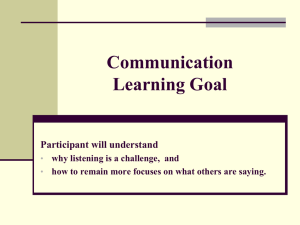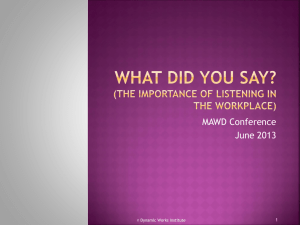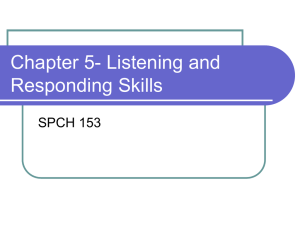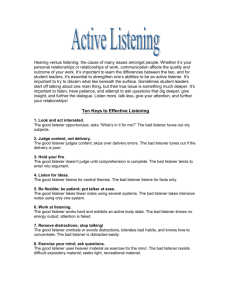COMMUNICATION Introduction
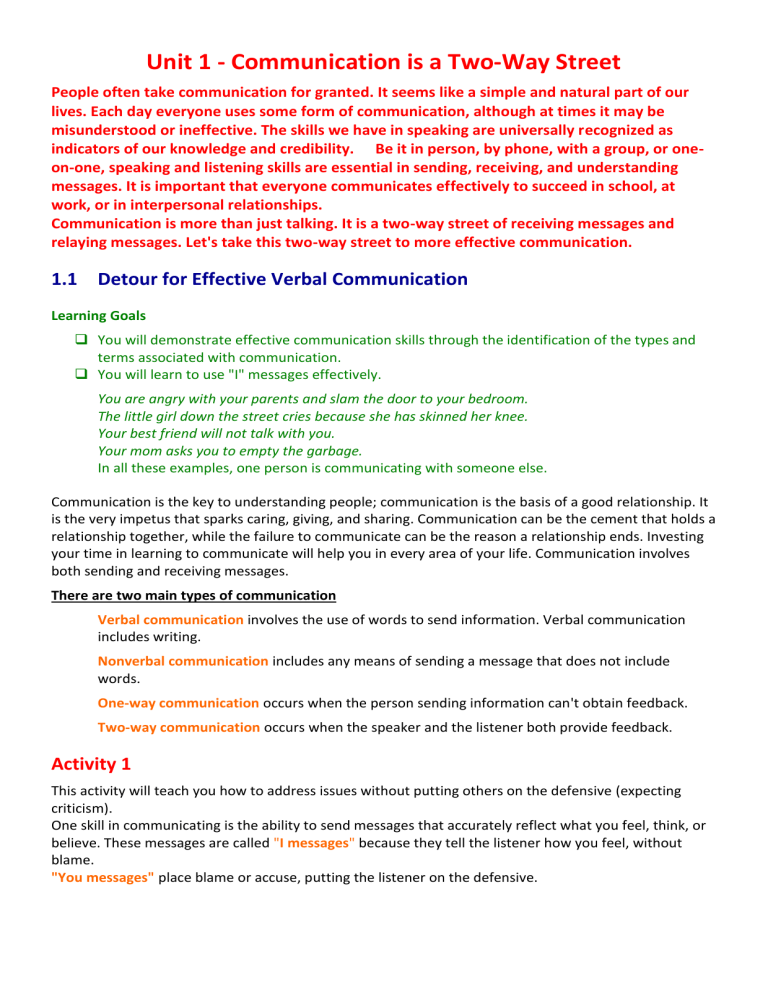
Unit 1 - Communication is a Two-Way Street
People often take communication for granted. It seems like a simple and natural part of our lives. Each day everyone uses some form of communication, although at times it may be misunderstood or ineffective. The skills we have in speaking are universally recognized as indicators of our knowledge and credibility. Be it in person, by phone, with a group, or oneon-one, speaking and listening skills are essential in sending, receiving, and understanding messages. It is important that everyone communicates effectively to succeed in school, at work, or in interpersonal relationships.
Communication is more than just talking. It is a two-way street of receiving messages and relaying messages. Let's take this two-way street to more effective communication.
1.1 Detour for Effective Verbal Communication
Learning Goals
You will demonstrate effective communication skills through the identification of the types and terms associated with communication.
You will learn to use "I" messages effectively.
You are angry with your parents and slam the door to your bedroom.
The little girl down the street cries because she has skinned her knee.
Your best friend will not talk with you.
Your mom asks you to empty the garbage.
In all these examples, one person is communicating with someone else.
Communication is the key to understanding people; communication is the basis of a good relationship. It is the very impetus that sparks caring, giving, and sharing. Communication can be the cement that holds a relationship together, while the failure to communicate can be the reason a relationship ends. Investing your time in learning to communicate will help you in every area of your life. Communication involves both sending and receiving messages.
There are two main types of communication
Verbal communication involves the use of words to send information. Verbal communication includes writing.
Nonverbal communication includes any means of sending a message that does not include words.
One-way communication occurs when the person sending information can't obtain feedback.
Two-way communication occurs when the speaker and the listener both provide feedback.
Activity 1
This activity will teach you how to address issues without putting others on the defensive (expecting criticism).
One skill in communicating is the ability to send messages that accurately reflect what you feel, think, or believe. These messages are called "I messages" because they tell the listener how you feel, without blame.
"You messages" place blame or accuse, putting the listener on the defensive.
Look at the example below.
Situation " You " Messages " I " Messages
A mother is mad because her teen is late for dinner again.
" You make me mad when you are late for dinner!"
I feel worried when you are not here at the right time, because I think something has happened to you.
(Note the difference in how the receiver might deal with this
statement.)
Sending "I" messages when you are upset is very difficult. It takes a lot of self-control to say how your feel rather than attack the other person.
Elements of an " I " message:
Allows expression of your own feelings
Lessens level of conflict
Non-blaming
Positive and effective
Includes these steps:
State person's name.
State how you feel.
State what you want.
Identify the issue.
Go to Activity 1 – Messages Worksheet
1.2 Stop, Look & Listen: Nonverbal Communication and Active Listening
Skills
Learning Goals
You will recognize some ways people communicate without words.
You will become more sensitive to cultural differences in nonverbal communication.
You will define and practice active listening skills.
Did you know?
We communicate as much without words as we do with words.
In some countries, such as Greece, a nod of the head would indicate "no." While in the U.S. it means
"yes."
Learning to be an active listener will greatly enhance your communication skills.
Assignment - Interview Skills
View this movie and make notes about good and bad interview skills. Record your notes in the assignment document. http://www.teachertube.com/viewVideo.php?video_id=43559&title=Interview_Skills
Go to Assignment – Interview Skills
1.3 Stop, Look & Listen: Active Listening Skills
Non-verbal Communication http://psychology.about.com/od/nonverbalcommunication/a/nonverbaltypes.htm
1.4 Roadblocks to Two-Way Communication
Learning Goal
You will define and practice active listening skills.
Active Listening
Definition: when the listener gives the speaker frequent feedback.
Purpose: to show the speaker that the listener understands the message.
Verbal feedback: involves repeating the speaker's message in your own words.
Learning to be an active listener will greatly enhance your communication skills.
This activity will give you tools and feedback techniques to participate in "two-way communication."
Three common ways to paraphrase (re-phrase or simplify what the other person says) are as follows:
"What I think I hear you saying is..."
"In other words, you think that..."
"Correct me if I'm wrong, but aren't you saying..."
Below is an example of an active listening dialog.
Sender: I'm so excited! I'm learning active listening skills in my personal development class. This will make me a more effective communicator.
Receiver: WHAT I THINK I HEAR YOU SAYING IS that you are learning how to use active listening skills to enhance your communication.
Sender: You are correct. The active listening skills technique is a form of two-way communication. The listener repeats in his/her own words what the sender is saying. This helps ensure that the message sent is the message that is received.
Receiver: IN OTHER WORDS, YOU THINK THAT this new skill is a way of clarifying what a speaker is trying to communicate to another person.
Sender: Yes, and additionally, the active listening process helps both the sender and the listener be better communicators.
Receiver: CORRECT ME IF I'M WRONG, BUT AREN'T YOU SAYING this process can improves everyone's communications skills?
Learning Goal
You will identify and describe three problems that occur in communication and learn ways to resolve those communication barriers.
Sometimes communication can be very difficult. Especially if you are constantly encountering roadblocks that close your two-way communication.
There are several ways that we place roadblocks in our conversations.
Roadblocks can be: avoiding subjects, mind reading, mixed messages, tuning out, different outlooks
and silence. By learning to identify these roadblocks, you can learn ways to open communication again.
To familiarize yourself with the various types of roadblocks to positive communication, carefully study
the material below.
AVOIDING SUBJECTS
In some families or relationships, some subjects are off-limits. Subjects like divorce, death, abuse, and sexuality are not easy to talk about, so people sometimes develop roadblocks to avoid them.
You can approach these subjects by sharing a similar circumstance that happened to someone else.
Sometimes having another person present will help ease into the communication process. Remember to use "I messages" so the person you are communicating with will not become defensive.
MIND READING
With mind reading, a person is assuming that he/she knows what the other person is thinking. The reasons people might try to mind read: a. Too impatient to listen to the other person.
b. A way to dominate the conversation.
Note: Mind readers very often reach the wrong conclusion about the other person's thoughts.
MIXED MESSAGES
Sometimes when messages are given and the other person is occupied doing something else, it gives a mixed message.
For example: You are talking with your friend and he keeps looking at his watch. You remark, "Are you listening?" He says, "Yes," and turns on the television. That is a mixed message.
SILENCE
Silence can send a very strong message that something is wrong. It can symbolize hostility, lack of interest, boredom, or "war." Sometimes, however, silence can mean the person is afraid. Very often the first response of frightened teens or children is silence. If someone in your life is silent much of the time, try to encourage communication.
TUNING OUT
Tuning out is a very common distraction from good communication. The television, loud music, or anything that distracts you from giving your total attention to the conversation is tuning others out. If you are really interested in communicating, it is important that you do not tune others out.
DIFFERENT OUTLOOKS
Because people are very different, we often perceive the world very differently. It is vitally important to try to see the other person's viewpoint in order to facilitate communication.
Go to Activity – Road Blocks
1.5 The Communication Zone
Learning Goals
You will identify barriers you may use in communication.
You will explore the difficulties that people from other cultures may experience when trying to communicate with people from different backgrounds/cultures.
People all over the world have established particular ways of communicating. They learn to express and communicate values, ideas, feelings, and interests. Ideally, the messages the person receives should be the same as the messages being sent. Sometimes differences in cultures can create misunderstandings in communication because people have learned to communicate a little differently.
This activity will help you look at how you learned to communicate and if, perhaps, you have some areas that may cause communication breakdowns or roadblocks.
Go to Activity – Communication Zone
1.6 Conflict Resolution
Learning Goals
You will learn how to solve conflicts peacefully.
You will learn red flags for violence escalation.
You will understand the process of dealing with conflicts.
Conflict usually occurs when people in a relationship experience an inability to communicate in an effective way. Each person may think his or her opinion is right, and that can lead to serious conflicts.
Knowing how you settle differences is essential in improving your communication skills. (Did you know
that the inability to get along with others is the #1 reason people lose their jobs?)
This activity examines communication patterns used to deal with conflict. When you know some basic guidelines, conflicts can easily end on a positive note. Through conflict resolution, you can develop more meaningful relationships and understand people more fully in family, social and work settings.
Remember conflict is inevitable, but... it does not have to be a direct path to a "knockout."
Conflict Resolution Style
Complete the following questionnaire and answer the questions in the worksheet. http://webhome.idirect.com/%7Ekehamilt/ipsyconstyle.html
Go to Worksheet – Conflict Resolution
Review of "I" Statements
The first step to remember is to state opinions on why you want something.
The goals of an "I" message are listed below: to avoid using "you" statements that will escalate the conflict to respond in a way that will de-escalate the conflict to identify feelings and validate the other person's feelings to identify behaviors that are causing the conflict to work toward resolution of the conflict
Remember to use "I" to express your feelings, identify the unwanted behavior and work toward resolution.





